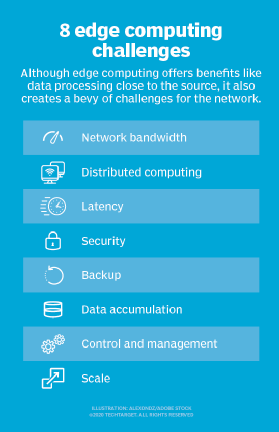
macrovector - Fotolia
3 challenges of edge computing, IoT network adoption
While edge computing and IoT devices can spark networking innovations, these technologies can also create challenges and pitfalls organizations aren't yet equipped to deal with.
The dawn of IoT and its networking potential began in the late 1990s, but organizations still face various roadblocks on the way to full-scale adoption.
Potential IoT network challenges can also forge challenges with edge computing, an architecture that supports IoT and processes data closer to the source. But many IT decision-makers view edge computing as a potential threat to their organization, according to a recent survey from network service provider Kollective Technology, based in Bend, Ore. The survey of 270 U.S. and U.K. IT decision-makers explored the top concerns about edge computing, IoT networks and how to build the two technologies into existing network infrastructures.
While 88% of respondents said IoT devices could enhance their business and network efficiency, nearly one-third reported their IoT projects didn't pass proof-of-concept stages due to various challenges. These challenges can also prevent organizations from reaping the potential benefits of edge computing and IoT, such as increased data and processing speeds and enhanced network efficiency.
The top challenges of edge computing, IoT network adoption
Security, lack of consistent regulations and an increase in BYOD, edge and IoT devices are three looming challenges with edge computing and IoT, according to the report. Despite the touted benefits of these technologies, the potential challenges impede organizations from full-scale adoption and deployments.
Security. More than 70% of respondents said the potential for security risks is their most pressing concern for edge computing and IoT. This ties into the pitfall of multiple edge and IoT devices, as a network's potential attack surface increases with each new device, the report said. Organizations may struggle to maintain control over each employee's multiple devices, and that lack of holistic visibility threatens their network security.

The IT industry also lacks a single, centralized OS specifically for IoT networks that organizations can safely rely upon, the report said. The absence of a central OS accepted throughout the industry can hinder centralized IoT network management and prevent consistent, reliable security and update processes. This impedes widespread edge computing and IoT adoption, as 86% of respondents said they required a central OS for their IoT operations.
Regulations. Around 30% of respondents said a lack of universal rules and regulations for device management is another challenge related to edge computing and IoT network architecture. While the U.S. and U.K. governments have developed IoT standards and regulations, many respondents said they were unsure how those regulations directly relate to their organization.
Without policies that can provide consistent expectations and general rules for these technologies, IT teams may not know what their IoT networks should look like or how the networks should function. Alongside IoT standards, IT decision-makers also require -- and lack -- BYOD policies and regulations in their organizations to enable reliable and efficient adoption of emerging technologies.
Devices. The growth of BYOD, edge and IoT devices can create issues for organizations that lack efficient infrastructure to support these devices, the report said. Nearly 40% of respondents said identification and deployment of edge devices and technology concerns them, and they may struggle with the volume of data at the network edge. Respondents also reported concerns about the potential for high latency as data moves from cloud environments to the network edge.
In addition, respondents cited concerns around how IT teams can integrate edge computing components with their existing network infrastructure. While software-defined services alleviate some deployment issues, organizations may face various trial-and-error processes before IT teams fully understand edge computing, IoT and how these technologies play with their network infrastructure.
Overall, respondents said the growing demand and popularity of edge computing, IoT networks and their devices will drive them to invest in infrastructure that can support these emerging technologies and devices. This will require IT teams to establish infrastructure that can both ensure device security and roll out consistent updates to a constantly increasing number of devices.
The report also said geographically distributed organizations may face more difficulties in this adoption than others, as edge computing and IoT could require all distributed offices to update their network infrastructures and branch offices may not have the proper staff or resources for this move.






